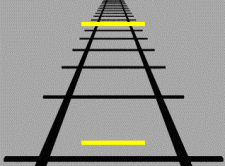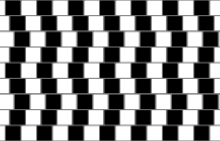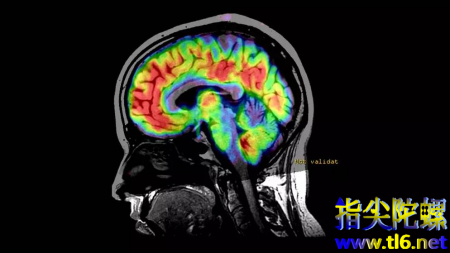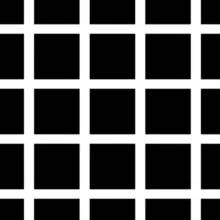黑林错觉:假如眼睛欺骗了你

Howyoureyes,trickyourmind
视觉错觉(或光学错觉)的存在表明:我们的大脑往往会臆度这个世界,眼见不一定为实。
纵览历史,已经有好奇的人发问:为什么我们的眼睛总是被这些简易图像迷惑。
已知的错觉现象能够向我们揭示大脑是如何将时间和空间加工处理成意识体验的。
错觉现象可以上溯至古希腊时代,自古有之。
公元前350年,亚里士多德曾指出:“我们的感知即可靠又易被蒙骗。”
他注意到:如果你注视瀑布一段时间,然后将视线就近转移到静止的石头上,就会发现石头似乎向着与水流相反方向移动。今天我们把这种现象称为“运动后效”或者“瀑布错觉”。
盯着水流一段时间后,大脑中特定的神经元会因为习惯了这种动态而产生疲劳。然后将视线就近转移到静止的石头上,脑中其它竞争神经元(competingneurons)的过度矫正,最终导致了石头向上移动的错觉。

19世纪,错觉研究迎来了真正的繁荣时期。一批来自不同领域、共同研究“感知行为”的科学家们,共同创制了简单的错觉图像,用于揭示大脑是如何认知图案的,这促进了早期错觉研究的形成。
比如说,艾斯浩宾错觉揭示了我们的大脑会参照周围事物来判断物体大小,我们甚至可以操纵这一感知行为。下图的两个橙色圆圈其实一样大。

▲艾斯浩宾错觉(EbbinghausIllusion)
几乎同时,蓬佐错觉表明背景(context)也是深度感知的基础。
该错觉图案表明,在透视感的作用下,置于“八字线”之中的等长线条会显得长短不一。就好比铁轨,透视作用中向远处聚合的平行轨道中等长的枕木,给人的感觉却是逐渐变短,最终消失在远方。
错觉图案混淆了大脑的感知,作为反应,脑中的神经元的“矫枉过正”最终导致等长的线条显得长短不一。这一原理在实际生活中多用于对“比例”的巧妙运用。

▲蓬佐错觉(MarioPonzoillusion)
缪勒莱耶错觉中的线段不等长和前文中的蓬佐错觉原理相通。线段两端的箭头,使大脑对于端点是向内靠拢还是向外发散产生了错觉,进而左右大脑对于线段长短的判断。
有些疑惑?要弄清其中奥妙,就请想一下相邻的两面墙与天花板在房间顶角汇集的样子:你会看到三条直线交汇到一点。
我们的大脑就是利用这些线条在三维空间中衡量纵深与远近的。换句话说,墙角的那一交点比向它汇聚而来的三条直线更远。
在缪勒莱耶错觉中,线段两端的箭头使大脑误以为这是一个三维立体场景。就如前文所举的例子,中间那条线段两端的箭头像极了房间的顶角,这使得大脑误以为这条线段是向外延伸的,脑中的神经元再一次矫正过度,使得这根线看起来更长一些。

▲缪勒莱耶错觉(Muller'sillusion)
不只是前文中的缪斯莱耶错觉,还有许多错觉图像可以用简单的线条扭曲大脑对外界的感知,并且其中奥妙很难解释。
19世纪末赫尔曼·冯·亥姆霍兹(HermannvonHelmholtz)首次证实:由垂直线段组成的正方形比由水平线段组成的正方形显得更矮更宽。

这也就是为什么横条纹衣服会使你看起来更高挑,而不是竖线条。(这与现今时尚界的建议相反)
研究人员推测该错觉的原理与大脑估量“填充空间”的方式有关,但他们始终没能弄清其具体原因。
在大脑感知研究取得突破性进展的背景下,早期错觉研究应运而生。
主流观点认为:我们只要弄清眼球中的成像方式,就能够弄清“视觉”的全部。错觉原理则与主流观点相悖,因而具有理论价值。
错觉研究虽尚未形成规模,但却真实可信;错觉研究在实验上易于操作,其中用简单图形制作的错觉图形,变化万千,令人啧啧称奇。
但是科研界在这一时期出现了一系列寻求“统一理论”的错误尝试,文学界也充斥着对错觉现象过度演绎的作品。
随着研究的进一步深入,我们发现与早期研究的解释相比,错觉现象中大脑的反应要复杂得多。
20世纪,错觉领域的研究并没有取得突破性进展。但对于大脑如何处理外界信息的探索仍在继续,并在“认知(perception)研究”方面取得突破。
科技的进步使得大卫·休伯尔(DavidHubel)和托斯坦·威泽尔(TorstenWiesel)发现:只有当物体处于一个特定的角度,大脑视觉皮层中(与之相对应的)特定的神经元才会活跃起来。意思就是说,你在观看三角形和正方形的时候,都有(与之相对应的)专门的神经元产生活跃。这一发现使他们获得了1981年诺贝尔奖。
科学家在哪里止步,艺术家就在那里开始。

▲AmazingOpticalIllusioninArt
21世纪初,错觉研究有所复兴,开始涉及大脑处理时间的奇怪方式。
一派观点认为:我们的大脑时刻都在试图预测未来,而错视图像凸显了其中的运作方式。理论上讲,大脑对未来的预测是为了补偿细微的感知延迟(大脑对外部世界的感知有十分之一秒的延迟)。
你正在阅读的文字首先是被眼睛接收,然后才是转变为电信号传导至大脑处理加工,这都是需要时间的。也就是说,你所感知到的不是现在,而是略微过去的世界。理论神经生物学家马克·强吉(MarkChangizi)认为:大脑预测未来是为了“感知现在”。
研究表明,经典的咖啡墙几何错觉证实了这一理论,例如黑林错觉。

▲咖啡墙错觉(caféwallillusion):平行线在错觉图像中显得不平行。
黑林错觉,即为放射线所产生的移动假象。其与现实世界中我们向前移动时所看到的景象类似,所以大脑误以为这些静止的线段或条纹移动了位置。
在现实生活中,当各项生理机能正常时,向前运动确实会在眼睛背面产生放射线;但在实验室中,大脑由于直接看到了放射线而由结果反向推理得出“图像移动了位置”的结论。

▲黑林错觉(Heringillusion):两条平行直线在放射线的映衬下显得弯曲了。
现如今,错觉研究再度兴起。
由于科技的进步,科学家得以窥探错觉现象中的大脑活动,并逐步了解其中的潜在机制是如何运作的。

功能性核磁共振成像技术的出现,使研究人员得以分析脑神经元在单个错觉现象中的反应活动。
举个例子,人在注视奈克方块(Neckercube)时的脑成像研究显示:大脑会通过不停地来回切换两个相异的视图,尝试着将一个平面图像转化为三维立方体。这进一步证实了大脑会被错觉图像欺骗,以至于误将奈克方块视为三维立体图像。

▲奈克方块(图左)是一个由12条线组成的二维图像,却有三维立体效果。奈克方块是个有歧义性的图,(图中)一种诠释方式是在一个较高位置看透明立方体的俯视图,(图右)另一种诠释方式是在一个较低位置看透明立方体的仰视图。
让我们把视线转向赫尔曼栅格错觉:你会在黑白网格的交错之处看到一个灰点,虽然它们并不真实存在。但当你直接注视其中一个灰点的时候,它却消失了。基于脑扫描的研究结果表明,为了对图像的明暗部分进行处理,我们的神经元会相互竞争。但这种解释只是一家之言。

▲赫尔曼栅格错觉(gridillusion)
但是,近年来的研究进展并不能解释所有的错觉现象。即便是前文中对赫尔曼栅格的解释也存有争议,因其无法解释当网格的线条变弯时产生的效果变化。
我们已知大脑会分区处理颜色、形状、运动和质地等外界信息,但是我们仍未弄清大脑是如何将这些信息转译、重组成一个连贯画面。
况且人们一直在发掘新的错觉现象,并且对已有的错视进行不断改造,甚至有视觉研究者为此举办了年度竞赛。亚利桑那州巴罗神经学研究所的视觉神经学家苏珊娜·马丁内斯·康德(SusanaMartinez-Conde)是该竞赛的评委之一。该竞赛的每一个参与者都各取所需,苏珊娜则是为了从新的错觉现象中获取脑科研究的灵感而来。
▲世界错觉大赛一等奖作品
所有的错觉研究都指向了一点:我们的视觉系统仍有其局限性,以至于无法处理眼睛所接收到的所有信息;反之,我们的大脑在体积上就算是大过楼房也不够。
因此大脑走了捷径,这就好比在赌马场下注,面对我们所看到的世界,大脑在时刻不停地选择最可能的解释。
显然,眼之所见,不一定总为实。
--本文原刊载于BBCCulture
由我和如果哈利不波特合译--
原文
Howyoureyes,trickyourmind
Visual,oroptical,illusionsshowusthatourmindstendtomakeassumptionsabouttheworld–andwhatyouthinkyouseeisoftennotthetruth.
Throughouthistory,curiousmindshavequestionedwhyoureyesaresoeasilyfooledbythesesimpledrawings.Illusions,wehavefound,canrevealeverythingfromhowweprocesstimeandspacetoourexperienceofconsciousness.
Scrolldownourinteractiveguidetofindoutwhy.
Illusionshavealonghistory,goingasfarbackastheancientGreeks.
InAD350,Aristotlenotedthatthat“oursensescanbetrustedbuttheycanbeeasilyfooled”.
Henoticedthatifyouwatchawaterfallandshiftyourgazetostaticrocks,therocksappeartomoveintheoppositedirectionoftheflowofwater,aneffectwenowcall“motionaftereffect”orthewaterfallillusion.
Trackingtheflowofthewaterseemsto“wearout”certainneuronsinthebrainastheyadapttothemotion.Whenyouthenshiftyourgazetotherocks,othercompetingneuronsover-compensate,causingtheillusionofmovementintheotherdirection.
Therealboominstudyingillusionsbeganinthe19thCentury.Aschoolofscientistswhostudiedperception–amongmanyotherthings–createdsimpleillusionstoshedlightonhowthebrainperceivespatternsandshapes,whichkick-startedtheearlytheoriesonhowoureyescanplaytricksonourmind.
TheEbbinghausillusion,forexample,revealedthatourbrainmakesjudgementsaboutsizeusingadjacentobjects–andthiscanbemanipulated.Theorangecircleshereareactuallythesamesize.
Aroundthesametime,thePonzoillusionillustratedthatcontextisalsofundamentalfordepthperception.
Itshowsthatidenticallysizedlinescanappeartobedifferentlengthswhenplacedbetweenconvergingparallellines.Thisshowshowoursenseofperspectiveworks.Likeatraintrack,theslantedlinesmakeusbelievethetoplineisfurtheraway.
Thisconfusesthebrain,anditovercompensates,makingthelineappearbigger–asitwouldhavetobeinreallifetoproducethosekindsofproportions.
Forsimilarreasons,thismaybewhythelinesintheMuller-Lyerillusionappeartobedifferentlengths.Thearrowsateachendaretrickingthebrainintothinkingthelinesarenearerorfurtheraway.
Confused?Tounderstandwhy,considerhowtwowallsmeettheceilingatthetopofaroom:you’llseethreelinesconverging.Thebrainusestheselinestogaugeperspectiveanddistancein3Dspace–inotherwords,thatthepointofthecornerisfurtherawaythanthelinesconvergingtowardsit.
OnetheoryisthatthearrowsoneitherendofthelineintheMuller-Lyerillusiontrickthemindintothinkingitislookingatasimilar3Dscene–forexample,thearrowsonthemiddlelinearesimilartoawall-ceilingcorner.Thisnudgesthebrainintothinkingthelineisfurtheraway,andagain,itovercompensates,makingitappearlongerthantheotherlines.
Thatisn’ttheonlywaysimplelinescanwarpthewaythemindprocessestheworld–andthereisn’talwaysasimpleexplanation.Inthelate1800s,HermannvonHelmholtzfirstdemonstratedthatasimplesquaremadeupofverticallineslooksshorterandwiderthanasquaremadeupofhorizontallines.
Thisiswhywearinghorizontallystripedclotheswillmakethewearerappeartallerandslimmer–contrarytofashionadvice.
Researcherssuspectthereasonistodowiththewayweestimate“filledspace”,butthey’restillnotsurewhyithappens.
Earlyillusionslikethisappearedataground-breakingtimeforthestudyofperception,saysillusionhistorianNicholasWadefromtheUniversityofDundeeinScotland.
“Theywereofinteresttheoreticallybecausetheywentagainsttheprevailingviewthatyoucouldunderstandvisionifyouunderstoodthewayinwhichanimageisformedintheeye.
“Thephenomenaweresmallbutreliable;theywereexperimentallytractableanditgeneratedthisincredibleboomofvariationsonsimplefigures.”
Yetthisperiodalsosawaseriesofmisguidedattemptstofinda‘unifyingtheory’ofillusions.Theliteratureonillusionsis“litteredwithover-interpretations”,saysWade.
Asresearcherswouldlaterdiscover,ourreactionstoillusionscanbeevenmorecomplicatedthantheearlypioneersrealised.
The20thCenturysawlittleinthewayofabreakthroughinthefieldofillusions.
Butthequesttounderstandhowweprocesstheworldcontinued,andthisresultedinsomeexcitingfindingsaboutperception.
Forexample,advancesintechnologyallowedDavidHubelandTorstenWieseltodiscoverthatcertainneuronsinthebrain’svisualcortexfiredonlywhenobjectswereorientatedatcertainangles–so,forinstance,specificneuronsfirewhenyoulookatasquareandatriangle.ThefindingearnedthemaNobelprizein1981.
Yetwherescientistsleftoff,artistsmovedforward...
Fastforwardtotheearly2000sandtherewasaresurgenceinillusionresearch,includinglookingatthestrangewayourbrainsprocesstime.
Oneschoolofthoughtsuggeststhatsomeillusionshighlightthewaythebrainconstantlytriestopredictwhatwillhappen.Thetheorygoesthatmanyillusionsshowthatwetrytopredictthefuturetocompensatefortheslightdelaybetweenaneventandourconsciousperceptionofit.
Thelightfromthesewordsyouarereadinghastoreachyoureye,beforeasignaltravelstothebraintobeprocessed–thistakestime,whichmeanstheworldyouperceiveisslightlyinthepast.MarkChangizi,atheoreticalneurobiologist,believesthebrainmaymakepredictionsaboutyoursurroundingsinorderto“perceivethepresent”.
InastudyChangiziworkedonwithShinsukeShimojo,ofCaltech’sexperimentalpsychologylabinCalifornia,theywrotethatawholeclassofclassic“coffee-table”geometricalillusionsfitwiththistheory,suchastheHeringillusion.
TheHeringillusion,saysChangizi,featuresradiallinesthatgivetheillusionofmovement,similartothesceneweseeaswemoveforwardintherealworld.Ourbrainhasthereforeevolvedtotreattheseradiallinesorstreaksasiftheyaremotion,hesays.
“Inreallifewhenthosemechanismsareworkingwell,whenyou’removingforward,thenthoseradiallineshappeningonthebackofyoureyereallyareduetoreal-lifemotion.Thereasontheyareonlymisperceptionsinthelabisbecauseradiallinestrickyourbrainintothinkingthere’smotion.”
Today,illusionresearchisboomingoncemore.
Technologyadvancesnowallowscientiststopeerinsideourbrainsaswelookatillusions,andtobegintounderstandtheunderlyingmechanismsgoingoninsideourhead.
Functionalmagneticresonanceimaging(fMRI)allowsresearcherstoanalysehowtheneuronsinourbrainrespondtoindividualillusions.
Forexample,abrain-imagingstudyofpeoplelookingattheNeckerCube,right,showedthatthebraincan“flip”betweentwodifferentviews,asitattemptstotranslateatwo-dimensionaldrawingonapageintoathree-dimensionalcube.Inotherwords,itconfirmedthatthebrainistrickedintoperceivingthecubeasa3Dobject.
OrconsidertheHermanngrid:weseegreydotsintheintersectionsbetweenthewhiteandblackgrideventhoughtheyarenotactuallythere.Butlookdirectlyatoneofthegreydotsanditdisappears.Basedonbrain-scanningresearch,oneexplanationisthatourneuronsarecompetingwitheachothertoseethelightanddarkpartsoftheimage.
However,theserecentadvancesdonotmeanthatallillusionscanbeexplained.EventhisexplanationfortheHermanngrid–anillusionwhichismorethanahundredyearsold–hasbeendisputed,sinceitcan’taccountforthefactthattheeffectchangeswhenthegridhascurvedlinesinsteadofstraightones.
Whileweknowthatdifferentareasofthebraindealwithcolour,form,motionandtexture,howthebrainencodesandcombinesthisinformationintoacoherentpictureremainspoorlyunderstood.
What’smore,newillusions,andvariantsonoldonesareappearingallthetime.Visionresearchersholdanannualcompetition,nowinits10thyear,tofindthebestnewillusions.OneofthejudgesisvisualneuroscientistSusanaMartinez-CondefromtheBarrowNeurologicalInstituteinArizona.Thecontesthasaselfishmotivationofsorts,shesays:shewantstokeepaneyeoutforinterestingnewillusionsthatwillhelphertostudythebrain.
Allofthisresearchpointstoonething:ourvisualsystemremainstoolimitedtotacklealloftheinformationoureyestakein.“Forthatourbrainwouldneedtobebiggerthanabuilding,andstillthenitwouldn’tbeenough,”saysMartinez-Conde.
Andsoourmindstakeshortcuts.Likebettingforthebesthorseinarace,ourbrainconstantlychoosesthemostlikelyinterpretationofwhatwesee.
Seeing,then,iscertainlynotalwaysbelieving.